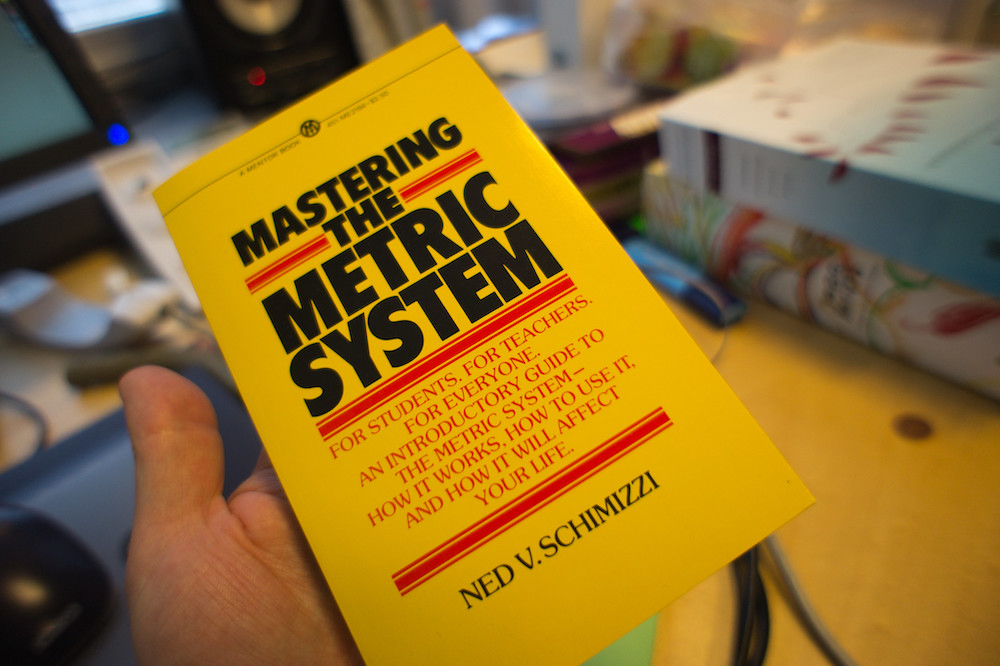Those Annoying Imperial Units!

This morning I discovered that the Sustainable Building Association in the UK had linked to our site, writing:
Energy Vanguard has a huge amount of excellent building science and especially air tightness info. Sadly it is US based which means annoying imperial units, and often discussions on US regulations and standards. Some here might never the less appreciate the often technical in depth discussions. [Emphasis added]
So I’ll say it again: It’s time for the US to join the rest of the world! Using a system of units that seems easy only because it’s the one we know and having to convert to a more sensible system when we want to talk to the rest of the world is nuts.
Hey, if I can tilt at the HVAC windmill, why wouldn’t I go after this one, too?!
Allison A. Bailes III, PhD is a speaker, writer, building science consultant, and the founder of Energy Vanguard in Decatur, Georgia. He has a doctorate in physics and is the author of a popular book on building science. He also writes the Energy Vanguard Blog. You can follow him on Twitter at @EnergyVanguard.
Related Articles
The Metric System Is for Lovers—A Valentine’s Day Manifesto
The Easy Way to Convert between Celsius and Fahrenheit
Photo of book by Aslak Raanes from flickr.com, used under a Creative Commons license.
Comments are closed.
This Post Has 10 Comments
Comments are closed.

Good luck, but I don’t see it
Good luck, but I don’t see it happening. The cooking world would be turned on it’s head. Things like cups, fl oz, quarts, pints, gallons would no longer need complex math formulas to convert. Everything would be in ML. Hospitals already “get it” and use metric system, as do most scientists.
I wholeheartedly agree that
I wholeheartedly agree that we should make the switch (it will only hurt for a minute!).
But I would remind those Brits that we got those units from them 😉
Good luck with that, Allison.
Good luck with that, Allison. I have been wondering why I need two sets of wrenches for 40 years. And having to clarify F or C when writing to friends in Europe is not a huge hassle, but making the conversion sure is. Give it time, maybe when we are both dead & gone, someone will finally get it, but I doubt it. But thanks for trying.
Why didn’t you hold off on
Why didn’t you hold off on posting this for just 9 more days and made it a Valentines Day sequel to last year’s metric system post? My, has it been a whole year…where does the time go, and why isn’t anyone bent out of shape by the fact we’re not using a decimal calendar? 😀
“Release the Kraken!”
When I was in 3rd grade they
When I was in 3rd grade they told us we all had to learn the metric system because the US was about to switch.
Thing is, we already use it. It’s called money.
Actually, if I may indulge
Actually, if I may indulge myself for a moment here…
The calendar most of us use on a daily basis is actually a pretty interesting (and arbitrarily complicated) computational structure. It’s a hierarchy of several very diverse, and rather arbitrarily fitted-together, units.
At the top levels of the hierarchy, you’ve got the Gregorian metrics of years, months, 24-hour days, and the somewhat arbitrary rules for relating/combining those.
Then, you have those base-60 divisions of hours into minutes, and minutes into seconds.
Then, at the lowest levels of the hierarchy, we finally employ the metric system, with 10ths of seconds, 100ths of seconds, milliseconds, microseconds, etc.
And we express a precise moment in time using a single value of, not one unit, of course, but several combined; for example
09.25.1960.16:15:23.9
while usually not even respecting the relative order of the hierarchy at the highest level. (BFD that the Brits pride themselves on writing the day of the month first..the order is still wrong, from a hierarchical perspective).
So, if time, as a dimension, is so critical to science (every bit as critical as lineal or volumetric measurements), why aren’t scientific and technically-minded folks freaked out by any of this?
I suppose it’s because in typical use, one usually works with just one or several adjacent levels of the time hierarchy, without being required to convert (or aggregate, or allocate), values up or down this rather quirky hierarchy.
Just some food for thought from one of the resident contrarians… 😀
– John
Here in Canada we officially
Here in Canada we officially switched to metric several years ago along with everyone else but the U.S.. Most tradesmen however still use the imperial system and our supermarkets post both prices usually with the Imperial in the larger print. It looks as if a total switch is going to take us a lifetime or two. I have also noticed that the U.S is making the switch in many areas without it being official. Possibly the border influences of Mexico and Canada. Don’t sweat it Alison, it will happen but not likely in your lifetime or mine.
This coming from a country
This coming from a country that uses both metric and imperial. Speed limits are still MPH and distances in miles. And the last time I ordered a Guiness in the UK, it was a pint, not a liter.
Right after WWII when the US
Right after WWII when the US was the world power; calling the shots there was a world conference on measurement standerds.The congressmen partied all night and didn’t make most of the meetings.that is why the problem.3/64″and 20thousands is more accrate or si units
Worthy cause, keep going.
Worthy cause, keep going.